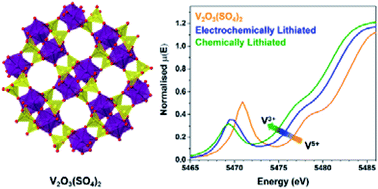Lithiation of V2O3(SO4)2 – a flexible insertion host†
Abstract
Materials that display strong capabilities for lithium insertion without significant change in unit cell size on cycling are of considerable importance for electrochemical applications. Here, we present V2O3(SO4)2 as a host for lithium-ion batteries. Electrochemically, 2.0 Li+ ions can be inserted, giving Li2V2O3(SO4)2 with an oxidation state of V4+, as determined by X-ray absorption spectroscopy. The capacity of V2O3(SO4)2 can be increased from 157 mA h g−1 to 313 mA h g−1 with the insertion of two additional Li+ ions which would drastically improve the energy density of this material, but this would be over a wider potential range. Chemical lithiation using n-butyllithium was performed and characterisation using a range of techniques showed that a composition of Li4V2O3(SO4)2 can be obtained with an oxidation state of V3+. Structural studies of the lithiated materials by X-ray diffraction showed that up to 4.0 Li+ ions can be inserted into V2O3(SO4)2 whilst maintaining its framework structure.



 Please wait while we load your content...
Please wait while we load your content...